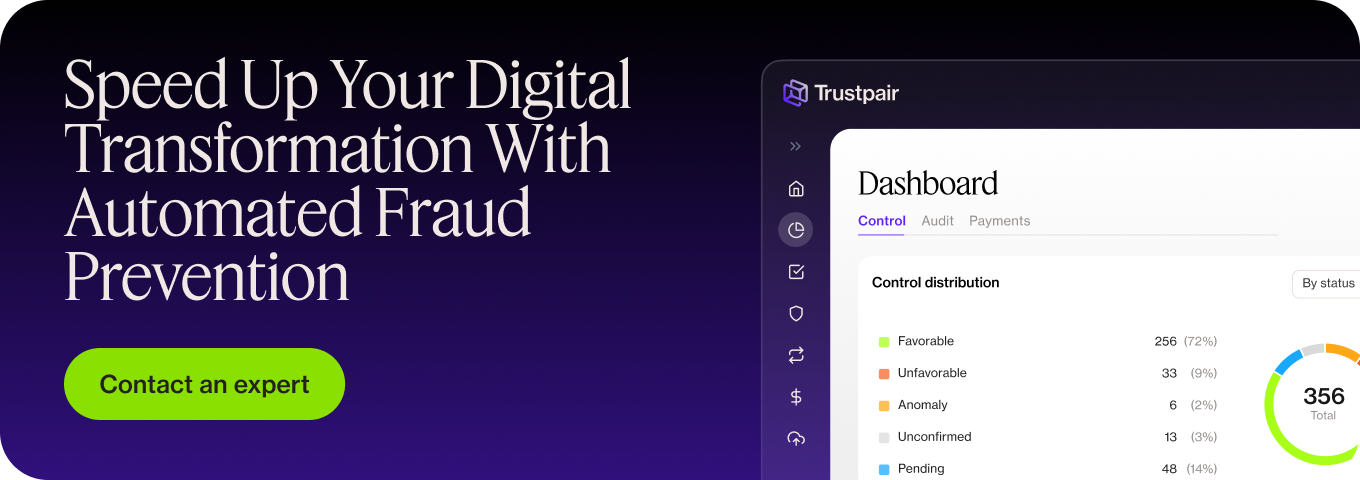Anti-Money Laundering Authority (AMLA) is the EU’s answer to its gaps in money laundering prevention. As cryptocurrency has exploded in popularity and new technologies penetrate financial safeguards, approximately 70% of all criminal networks in the EU rely on money laundering in one form or another.
The AMLA should hinder the funding of illicit activities, through transparency in businesses, banks, and account owners. Trustpair helps businesses comply with their AML requirements by strengthening third-party risk management and detecting suspicious payment data. Contact an expert to learn more!
What is the new EU Anti-Money Laundering Authority (AMLA)?
The new EU anti-money laundering authority (AMLA) exists to harmonize high-risk entities and monitor the transfer of money to prevent money laundering and terrorist financing.
The AMLA is a temporary authority, working across the European Union to support financial intelligence, in that they aim to facilitate the flow and exchange of information between national supervisors. It came into force in 2024 and is expected to begin making key changes in mid-2025.
By providing a “single EU rulebook”, the new regulatory body aims to standardize how each jurisdiction approaches anti-money laundering. Having already adopted a package of rules, the private sector will see changes in the coming years related to the tightening of due diligence requirements, supervisory powers, and sanctions.
There has been a recent focus on cryptocurrency by regulators around the globe due to the lack of transparency – determining the ultimate beneficial owners of any transfer is harder, and money laundering has become rife on crypto platforms. As such, the AMLA extends previous guidance and protections within cryptocurrency use and the reporting required by facilitators.
Key responsibilities of AMLA in combating money laundering
After calculating that 1% of all gross domestic product in the EU is involved in suspicious financial activity, the EU reviewed its pre-existing guidance around anti-money laundering in 2019.
The regulators developed a six-pronged list of responsibilities:
- Effective implementation of existing AML frameworks
- Establishing a single EU rulebook
- Creating an EU-wide supervision body
- Supporting national financial intelligence units (NFIs)
- Enforcing legal provisions and the exchange of information
- Strengthening the international side of AML
The problems identified in previous regulations in money laundering prevention all centered around variance in the quality and effectiveness of measures in different jurisdictions.
Part of this was attributed to a lack of resources in some countries, but methodology, particularly in the identification of risks, was also to blame. And where some NFIs were unwilling to use the full powers made available to them, inadequacies may have increased the risk of suspicious financial activity in certain countries.
The AMLA therefore aims to plug these gaps and create a stronger overarching policy to prevent both money laundering and terrorist financing.
Steps to ensure compliance with AMLA requirements
With the AMLA still in its infancy, many organizations are still figuring out their next steps for compliance. Most of the AML requirements will apply to governments, but some companies, such as banks and financial services providers, will also have to assess and adapt.
EU Member States
- National risk assessments once every four years
- Create a national FIU framework for SARs
- Establish a national body for oversight
- Create a cross-border asset register for data on bank accounts and other financial information
- Strengthening protections for whistleblowers (including a focus on personal data protection)
Corporations
- Access national risk assessments once published to inform strategies against money laundering
- Submit suspicious activity reports under the FIU
- Use the EU’s risk categorization tool accordingly
- Continue with Ultimate Beneficial ownership checks
- Process personal data under the GDPR regulations, with new clarifications
The impact of AMLA on businesses: what you need to know
From a business perspective, AMLA will require the consideration of a few key changes as it’s implemented:
- The inclusion of certain information alongside wire transfers and crypto asset transfers (such as legal entity identifiers)
- Those dealing in crypto must hold extra identifying information due to the opaque nature of the currency system
- Share data with law enforcement agencies upon request (typically when money laundering is suspected)
- Ensure the accuracy of AML due diligence and ultimate beneficial ownership information
- Hit reporting requirements and develop better controls for compliance
In general, companies must strengthen their internal controls to reduce the risk of financial fraud across all sectors of the business.
A quick recap on the AMLA
The AMLA, the EU’s new anti-money laundering authority, was created to harmonize how individual governments and national agencies respond to the threat of money laundering and terrorist financing.
Businesses will have to step up their suspicious activity reporting and verify data like Ultimate Beneficial ownership to comply. Trustpair strengthens fraud management by automatically verifying vendors, ensuring compliance with AML regulations.





